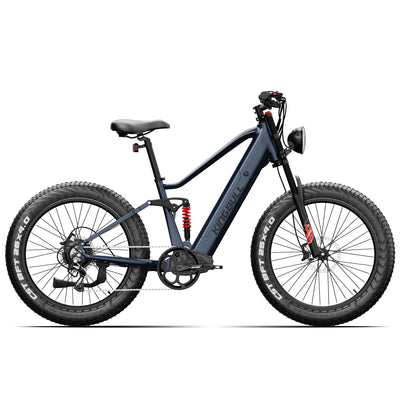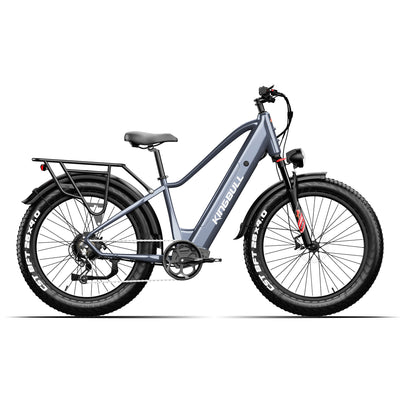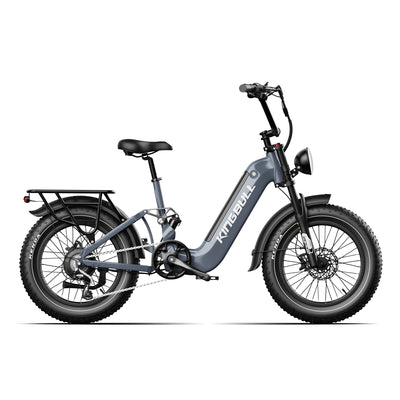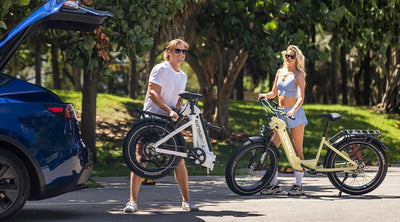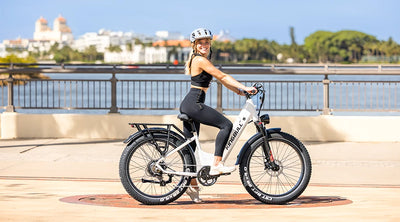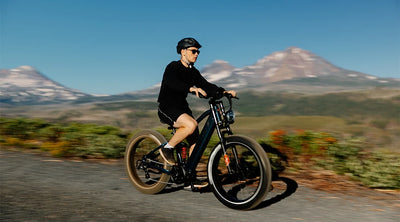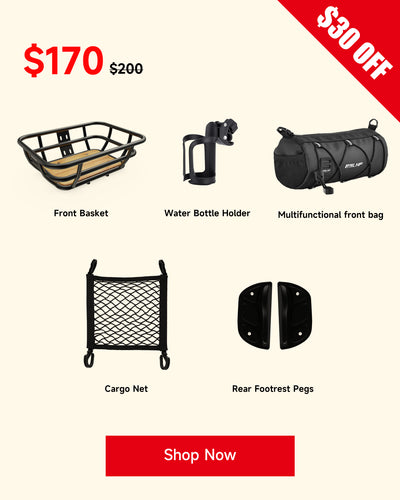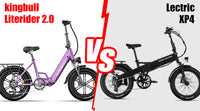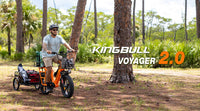Explore News

Ebike Comparison
The Ultimate Guide to Folding E-Bikes: Literider 2.0
Literider 2.0 — The Future of Urban Commuting, Folded
In the fast-paced world of urban commuting, a standout folding e-bike needs to master three essentials: portability, durability, and performance.
Meet the Literider 2.0 — Kingbull’s fully upgraded model, engineered to meet the demands of today’s rider. This isn’t just an upgrade. It’s our vision of what the future of city travel should feel like.
1. Frame: Strong, Light, and Built to Last
Crafted from high-strength 6061 aluminum alloy — the same material trusted in aerospace — the Literider 2.0’s frame delivers exceptional durability without extra weight.Its rounded, integrated-battery design not only looks sleek but also boosts rigidity and resists the wear and tear that folding bikes often face. The result? A lighter, stronger ride that’s effortless to carry upstairs, load into a trunk, or take on public transit.
2. Display: Smarter, Clearer, Better
The new high-contrast display replaces the basic screen of the first Literider. It clearly shows your speed, battery level, distance, and more — all at a glance. Stay informed and in control without breaking your focus on the road.
3. Motor: Powered by BAFANG
At the heart of the Literider 2.0 is a renowned BAFANG motor, delivering smooth, consistent, and responsive power. Hills? Handled. Quick starts? Effortless. It’s a motor built for city challenges.
4. Suspension: Comfort by MOZO
Urban streets aren’t always smooth. That’s why we’ve equipped the Literider 2.0 with a MOZO front fork, famous for its shock absorption. From potholes to cobblestones, your ride stays stable, comfortable, and fatigue-free.
5. Range: Go the Extra Mile
With optimized motor efficiency and an upgraded battery management system, you can ride up to 60 miles on a single charge. Longer commutes, weekend adventures, or spontaneous detours — no problem.
6. Colors: Your Ride, Your Style
Choose from classic black or white for timeless appeal, or go bold with green or purple. The Literider 2.0 is more than transport — it’s a style statement.
7. Seat: Comfort That Adapts to You
Our new eco-friendly slow-recovery leather seat molds to your body for personalized comfort and reduced pressure on long rides. Enhanced breathability keeps you cool, even on hot summer days.
8. Controller: Smarter Power, Longer Life
The upgraded controller software improves coordination between the motor, battery, and display for smoother rides and better energy efficiency. Less wear on components means more years of reliable performance.
The Literider 2.0 — Your Everyday Game-Changer
With its sturdy yet lightweight frame, powerful motor, premium suspension, and thoughtful upgrades, the Literider 2.0 is built to make city riding easier, more comfortable, and more fun.
Whether it’s your daily commute, weekend getaway, or just exploring the city, the Literider 2.0 folds neatly into your life — and your trunk.
🚴♂️ Ready to redefine your ride? Experience the Literider 2.0 today.
Read more
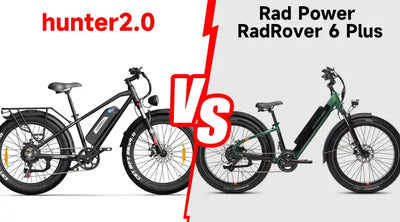
Ebike Comparison
Fat Tire E-Bike Showdown: Hunter 2.0 vs RadRover 6 Plus - Which Rules City & Mountain?
When it comes to conquering both city streets and mountain trails, fat tire electric bikes have become the go-to choice for adventure seekers. Today, we're putting two heavyweights head-to-head: the Kingbull Hunter 2.0 ($899) and the Rad Power RadRover 6 Plus ($1,599).
⚡ Power Performance: Dead Heat
Both bikes pack the same 750W motor - the sweet spot for electric bike power that provides excellent acceleration while staying street-legal in most areas. Whether you're climbing steep hills or cruising flat city roads, both deliver impressive performance.
Winner: Tie - Both offer identical motor power
🔋 Battery & Range: Hunter 2.0 Takes the Lead
Here's where things get interesting:
Hunter 2.0: 720Wh (15Ah) battery, 55-mile range
RadRover 6 Plus: 672Wh battery, 45-mile range
The Hunter 2.0 not only has a larger battery capacity but also delivers 10 extra miles of range. That's the difference between making it home or being stranded.
Winner: Hunter 2.0 - More power, longer rides
🛑 Braking System: Safety First
Both bikes feature hydraulic disc brakes, but the Hunter 2.0 goes a step further with dual-piston hydraulic brakes for superior stopping power and better modulation. When you're flying down mountain trails or navigating busy city traffic, every bit of braking performance matters.
Winner: Hunter 2.0 - Enhanced braking performance
⚙️ Drivetrain: Smooth Shifting
Both bikes sport 7-speed drivetrains, but the Hunter 2.0 features a Shimano 7-speed system - the gold standard for reliable, smooth shifting. RadRover's system works, but Shimano's reputation for durability and precision is unmatched.
Winner: Hunter 2.0 - Shimano reliability
🏔️ Suspension: Comfort on Any Terrain
Both bikes include front suspension, but the Hunter 2.0's oil-damped front fork with 80mm travel provides superior comfort and control. Whether you're hitting city potholes or rocky mountain trails, the Hunter 2.0 smooths out the ride.
Winner: Hunter 2.0 - Better suspension technology
🖥️ Display & Controls
The Hunter 2.0 features a color display that's easier to read in various lighting conditions compared to standard LCD displays. Clear information at a glance means safer riding.
Winner: Hunter 2.0 - Superior visibility
🎨 Style & Options
While the RadRover 6 Plus comes in limited color options, the Hunter 2.0 offers three distinct choices:
Classic Black
Sophisticated Beige
Unique Hunter Green
Winner: Hunter 2.0 - More personalization options
💰 The Price Reality Check
Here's the shocking truth:
Hunter 2.0: $899 (Limited time, was $1,699)
RadRover 6 Plus: $1,599
You save $700 with the Hunter 2.0!
That's not just savings - that's enough money for premium accessories, gear, or even a vacation to test your new bike.
🏆 The Verdict: Hunter 2.0 Dominates
While both bikes excel at city commuting and mountain adventures, the Hunter 2.0 delivers:
✅ Better range (55 vs 45 miles)
✅ Superior braking (dual-piston hydraulic)
✅ Premium components (Shimano drivetrain)
✅ Advanced suspension (oil-damped fork)
✅ Better display (color screen)
✅ More style options (3 colors)
✅ Unbeatable price ($700 less!)
🎯 Who Should Choose What?
Choose Hunter 2.0 if: You want the best performance per dollar, longer range, and superior components without breaking the bank.
Choose RadRover 6 Plus if: You have an extra $700 to spend on the same core experience.
🚀 Ready to Rule City & Mountain?
The Hunter 2.0 proves that you don't need to spend $1,599 to get premium fat tire e-bike performance. With superior specs, better components, and half the price, it's the clear winner in this showdown.
Limited time offer: Get your Hunter 2.0 for just $899 (regularly $1,699) with free shipping!
Read more
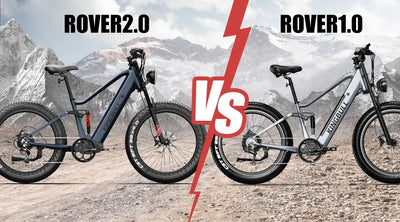
Ebike Comparison
Rover 1.0 vs. Rover 2.0: An Upgrade Comparison - What's New?
If you're thinking about getting an e-bike or upgrading your old Rover, this comparison is for you. We'll take a detailed look at the Rover 1.0 and Rover 2.0, priced at $1199 and $1399 respectively, to highlight the significant upgrades in the new model.
Core Power: A Comprehensive Upgrade
1. Branded Motor, More Powerful Performance
Both bikes are equipped with a 48V 750W brushless rear hub motor. However, the Rover 2.0's motor has been upgraded to a well-known industry brand: Bafang. Bafang motors are celebrated for their exceptional performance and reliability. The internal gears are specially treated to be more heat-resistant and durable, ensuring stable and reliable power output even during long, high-intensity rides.
2. High-Efficiency Battery, Longer Range
The Rover 1.0 comes with a 48V 17.5Ah lithium battery, while the Rover 2.0 uses a 48V 15Ah SAMSUNG lithium battery. Although the 2.0's battery has a slightly lower capacity on paper, it is equipped with a more advanced Battery Management System (BMS). This system significantly improves the battery's overall efficiency and safety, providing a comparable or even better range in real-world use and extending battery life.
3. Torque Sensor, A More Natural Riding Feel
This is one of the most significant upgrades to the Rover 2.0's riding experience.
The Rover 1.0 uses a cadence sensor, which only provides assistance based on whether you are pedaling.
The Rover 2.0 has been upgraded to a torque sensor. It precisely detects your pedaling force, providing more immediate and smoother assistance. When you pedal harder, the assistance is stronger; when you pedal gently, the assistance is lighter. This intelligent system makes the riding experience feel more like a traditional bike and requires less effort.
Comfort and Design: Superior Details
1. Branded Suspension, Smooth Ride on Rough Roads
Both bikes feature a full suspension design, but the 2.0 has upgraded its suspension components with name brands.
The front fork comes with a lock-out and preload adjustment function.
The rear shock is from the DNM brand and features both a coil spring and adjustable damping.
These branded suspension components provide a more precise and adjustable damping effect, greatly improving comfort and handling on uneven roads, trails, or long-distance rides.
2. Integrated Design, More Stylish Appearance
The Rover 2.0's frame design is more refined. It features an all-aluminum alloy frame, an integrated internal battery, a tapered head tube, and internal cable routing for a cleaner look. Notably, the battery color matches the frame color, creating a highly unified visual effect that makes the bike look more aesthetically pleasing and premium.
3. High-Performance Brakes, Guaranteed Safety
Both bikes use hydraulic brakes, but the Rover 2.0 has upgraded to dual-piston brake calipers from the ZOOM brand. This high-performance braking system offers more powerful and reliable stopping force, providing solid safety assurance for every ride.
Other Notable Upgrades
Display: The 2.0's display has been upgraded to a horizontal version with optimized color rendering, providing clearer and richer information.
Drivetrain: Both bikes feature a reliable Shimano 7-speed drivetrain for smooth shifting.
Lighting System: The front and rear lights are the same on both models and meet daily riding and safety needs.
Conclusion: Is the extra $200 worth it?
The Rover 2.0 offers significant upgrades for a price of $1399. While it's $200 more than the 1.0, the improvements deliver a quantum leap in the riding experience.
You get:
A Bafang motor with better performance and durability.
An intelligent, low-effort torque sensor.
A more comfortable branded suspension system.
A safer ZOOM brake system.
And a more aesthetically pleasing, integrated design.
If you're looking for a more comfortable, natural, and higher-quality riding experience, and your budget allows, the Rover 2.0 is an excellent choice. The comprehensive upgrades in core performance, riding comfort, and design details make it well worth the value.
Read more

Kingbull News
Kingbull Jumper Go Review: The Ultimate Off-Road E-Bike on a Budget
Electric bikes are now making waves in the outdoor adventure field, becoming trusted companions for more and more enthusiasts to explore nature and challenge the unknown. Kingbull, as an emerging brand that rose to prominence in 2023, has launched the Kingbull Jumper Go electric bike specifically designed for off-road use, thanks to its precise understanding of outdoor riding needs. This model aims to enable riders to easily conquer off-road trails, carry heavy loads, and complete all tasks with a rugged style, making it a popular choice for those seeking high-performance adventure electric bikes.
Key Highlights: Why It Catches Attention
First, let's look at the core highlights: What makes this "beast" so eye-catching?
Equipped with Bafang 750W motor + 960Wh Samsung battery, delivering excellent power and range
Features torque sensor for a riding experience far superior to ordinary cadence sensor models
Full suspension system + 4-inch puncture-resistant wide tires for maximum off-road capability
450 lbs (about 204kg) weight capacity, with rear rack supporting an additional 150 lbs - exceptional cargo capacity in its class
At $1,799 after discount(KBJG200), you get premium brand components with outstanding value
Performance: Power That Never Disappoints
The heart of any electric bicycle is "power," and Jumper Go absolutely delivers in this regard. Its Bafang G063 rear hub motor with 750W rated power and approximately 85Nm maximum torque, paired with the Shimano Altus 8-speed transmission, provides impressively "aggressive" power output whether on flat surfaces or steep climbs. Testing showed a top speed of 28mph (about 45km/h), with the option to adjust to 20mph (about 32km/h) for Class 2 compliance via the display.
The TROG-1B torque sensor on this bike is a game-changer - unlike ordinary cadence sensors that "wait" for pedal movement before providing power, it adjusts motor output in real-time based on your pedaling force. When climbing hills with more effort, it provides additional assistance; when cruising on flat roads, it "restrains" the power. This "intuitive" feedback eliminates any jerky sensation, making it feel like riding a "naturally enhanced" regular bicycle - effortless yet controllable.
Range: Distance That Sets You Free
Battery life anxiety? It’s basically non-existent on Jumper Go. It is equipped with a 48V 960Wh (20Ah) Samsung lithium battery and is UL certified, ensuring safety. In actual testing, under the 5th gear of power assist (PAS 5), the battery still had some power left after riding for 39 miles (about 63km) on mixed roads (flat roads + climbing). If you ride in low gear on a flat road, the range can easily exceed 50 miles (about 80km).
The thoughtful design integrates the battery within the full aluminum frame, providing dust, mud, and water protection while remaining removable for separate charging. The included 48V 3.0A charger takes just 6-7 hours for a full charge from empty - charge overnight and enjoy a full day of weekend adventures.
Safety: Brakes That Inspire Confidence
Safety is always the primary consideration for riding, and Jumper Go excels in this area. It features Tektro HD-E3940 four-piston hydraulic disc brakes with 180mm rotors front and rear. Testing on steep descents and loose gravel showed strong, linear braking power without the panic of "grabbing too hard and getting thrown," with no heat fade even during continuous braking.
The front 48V LED headlight provides sufficient illumination for dark forest trails; the rear light is intelligent, automatically brightening during braking to alert vehicles or pedestrians behind. The bike can support 450 lbs (about 204kg) and allows convenient installation of various accessories, further expanding the vehicle's practical functionality. Additionally, the bike is equipped with fenders that effectively block mud and water splashes, keeping both the bike and rider clean.
Capability: Strength That Handles Everything
The Kingbull Jumper Go is designed with off-road riding needs fully in mind. The full suspension combination of front Zoom 879DH coil spring fork (100mm travel) + rear DNM AO-38RC air spring (50mm travel) filters out most vibrations from gravel and potholes. Even riding over rock piles won't leave you sore from bouncing.
The 4-inch Kenda puncture-resistant wide tires not only provide exceptional grip for easily handling muddy, sandy, and various complex road surfaces, but also offer excellent puncture resistance, reducing the risk of flat tires. The rear rack can support 150 lbs (about 68kg), making it completely feasible to load camping gear, hunting equipment, or even add a passenger seat.
Riding Experience: Comfort That Transforms Every Journey
Jumper Go doesn't compromise on riding comfort. The eco-leather saddle is both soft and supportive - testing showed no discomfort after 3 continuous hours of riding. The adjustable stem allows you to find a comfortable position whether you prefer upright riding or aggressive forward positioning.
Combined with the dual filtering of full suspension and wide tires, even on bumpy surfaces, your hands and feet won't go numb from vibration. Five adjustable assist levels let you choose more exercise with less assistance or maximum ease with full power - ride however feels right.
Design: Engineering That Speaks Quality
Aesthetically, the full aluminum frame features bold lines with step-through design, making mounting and dismounting convenient for riders from 5'3" (1.6m) to 6'7" (2m).
The color display screen on the handlebars is intuitive, showing speed, battery level, assist level, and mileage at a glance. Standard equipment is comprehensive: front and rear fenders (no mud spray in rain), rear rack (cargo capacity), side kickstand (stable parking), and even an electric horn (trail courtesy alerts) - basically no need for additional accessory purchases.
Price: Value That Redefines Expectations
Originally $1,999, use discount code KBJG200 for $200 off, bringing it to $1,799. At this price, getting Bafang motor, Samsung battery, Shimano transmission, Tektro hydraulic brakes, full suspension + wide tires is undoubtedly exceptional value. Compared to similar off-road e-bikes, the value proposition is very high!
Conclusion: A Must-Buy for Adventure Seekers
If you're an off-road enthusiast wanting a powerful, durable, safe electric bicycle, Jumper Go absolutely delivers. If you frequently need to carry heavy loads (camping, deliveries, etc.), its 450 lb capacity handles it easily.
Of course, if you only need city commuting, the 81 lb weight might be "overkill." But for those pursuing "unrestricted wilderness adventures," this Kingbull Jumper Go truly is "the optimal solution within budget."
Kingbull Jumper Go Core Specifications Overview
Feature
Details
Motor
Bafang G063 750W rear hub, ~85Nm torque
Battery
48V 960Wh Samsung lithium-ion
Range
Up to 80 miles (129 km) on low PAS
Brakes
Tektro 4-piston hydraulic disc brakes (180mm)
Suspension (Front)
ZOOM 879DH, Coil Spring, 100 mm Travel
Suspension (Rear)
DNM AO-38RC Air Spring, 50 mm Travel, Lockable
Tires
20”×4.0” Kenda puncture-proof fat tires
Max Load
450 lbs (204 kg); Rear rack: 150 lbs (68 kg)
Want more technical details?Read the complete professional review: EBikeDaily - Kingbull Jumper Go: A Rugged Fat Monster on Budget!
Read more

Maintenance
Beat the Heat: Your Essential Guide to Summer E-Bike Riding
Summer's officially here, and you know what that means: longer days, epic rides, and the perfect excuse to hit the trails on your e-bike! But as the temperatures crank up, a little extra love for your ride (and yourself!) goes a long way. This guide's packed with useful tips to keep you cruising safely and your e-bike humming happily all season long.
1. Before You Ride: Prep Yourself & Your Bike for the Heat
Personal Prep:
Lightweight, Breathable Gear: Opt for light-colored, moisture-wicking fabrics (like athletic quick-dry wear) to reflect sun and keep you cool.
Sun Protection is Key: Apply high-SPF sunscreen, wear UV-protective sunglasses, and consider a wide-brimmed hat (helmet-compatible) or neck gaiter for extra coverage.
Ventilated Helmet: Choose a helmet with ample vents to ensure proper airflow and head cooling.
Hydrate, Hydrate, Hydrate: Drink plenty of water before, during, and after your ride. Don't wait until you're thirsty—that's already a sign of dehydration. Carry plenty of water, ideally in an insulated bottle to keep it cool. For longer rides, plan out water stops.
Bike Check:
Tires:
Tire Pressure: High temperatures can increase tire pressure. Always use a tire gauge to check pressure before riding, adjusting to the recommended range (usually 25-30 PSI, check your bike's manual or tire sidewall). Over-inflated tires risk blowouts, while under-inflated ones can lead to flats and reduced efficiency.
Tread & Debris: Inspect the tire surface for cracks, bulges, or excessive wear (where wear indicators are visible). Remove any embedded stones, glass, or debris from the tire treads to prevent punctures during your ride.
Brakes:
Brake Feel: Squeeze the brake levers to check for responsiveness and firm return. They should feel consistent and strong.
Pad Wear: Inspect brake pad thickness (for both disc and V-brakes). If they're worn down or making screeching noises, replace them promptly. For disc brakes, check rotors for warping or oil residue.
Cables/Hoses: Look for any signs of rust or stickiness in brake cables, and check hydraulic brake lines for leaks.
Battery:
Visual Check: Inspect the battery pack for any damage, swelling, or leaks. Ensure it's securely mounted to the bike frame.
Charge Level: Confirm you have enough charge for your planned ride. Avoid riding long distances on a very low battery, as this can strain it.
Connectors: Check that battery terminals and charging ports are clean and dry, free of debris.
2. During Your Ride: Ride Smart, Stay Safe
Avoid Peak Heat Hours: Whenever possible, ride during cooler times of the day, like early mornings, evenings, or after sunset. Try to avoid the hottest hours between 10 AM and 4 PM. If you must ride in the heat, plan for more frequent, longer breaks in shady spots.
Use That Assist Wisely: Take advantage of your e-bike's power assist. In hot weather, use higher assist levels to reduce your physical exertion, keeping your body cooler. Avoid prolonged high-intensity riding, which can overheat the motor and battery. If you notice them getting too hot, stop and let them cool down.
Watch the Road: Pavement can get extremely hot in summer, potentially affecting tire softness or grip. Be extra cautious on wet spots (like freshly watered roads or post-rain puddles), especially when turning. Choose routes with more tree cover to avoid constant direct sunlight on asphalt.
Listen to Your Body: If you feel dizzy, nauseous, rapid heartbeat, extreme fatigue, or muscle cramps—these are signs of heatstroke. Stop immediately, rest in a cool, shady spot, and rehydrate (ideally with electrolyte drinks). Seek help if symptoms persist.
3. After Your Ride: Post-Ride Care for Longevity
Battery Care:
Cool Before Charging: Don't charge your battery immediately after a ride, especially if it's warm. Park your e-bike in a cool, well-ventilated area and let the battery cool down naturally (usually 30-60 minutes, depending on ride intensity).
Safe Charging Environment: Always use the original charger in a dry, well-ventilated area away from direct sunlight and flammable materials. Avoid charging in enclosed, hot spaces.
Avoid Overcharging/Over-discharging: Disconnect the charger once the battery is full; avoid leaving it plugged in overnight. Similarly, try not to drain the battery completely; keeping it between 20-80% charge generally extends its lifespan.
Long-Term Storage: If storing your e-bike for an extended period, remove the battery (if removable) and keep it in a cool, dry, well-ventilated place with a 50-80% charge. Check the charge monthly.
Tire & Brake Care:
Tires: Clear any dirt, mud, or small stones from the tire treads. If storing long-term, avoid putting constant pressure on one part of the tire; slightly over-inflate or rotate the wheels regularly to prevent flat spots.
Brakes: Keep brake pads and rotors (for disc brakes) clean from oil and dust, which can affect performance. If rotors are oily, clean them with a specialized brake cleaner. Regularly check brake cable tension or hydraulic fluid levels.
General Cleaning & Maintenance:
Summer can mean more rain or dust. Clean your e-bike promptly after rides, paying special attention to the chain, gears, and other drivetrain components, then lubricate the chain.
Avoid using high-pressure washers directly on the battery, motor, or other electrical components. Use a damp cloth for cleaning, and specialized bike cleaners when necessary.
When to Consult Professionals for E-Bike Maintenance
Knowing when to call in the pros for e-bike maintenance is crucial for keeping your ride safe and performing its best. Here's when to reach out:
Strange Noises: Hearing grinding or clicking sounds? These often signal deeper mechanical issues that need expert attention.
Brake Issues: Even after regular home upkeep, if your brakes don't feel right, have a technician inspect them. Your safety on the road is paramount.
Electrical Hiccups: If you're experiencing inconsistent power, unresponsive controls, or any other electrical problems, reach out to us immediately at customers@kingbullbike.com for dedicated support.
Summer Fun Awaits: Ride On, Worry-Free!
So there you have it! Summer e-biking is all about soaking up those rays and hitting the trails. By giving your e-bike (and yourself!) a little extra love with these simple tips, you'll keep everything running smoothly even when the mercury rises. Think of it as tuning up your ride for maximum fun and minimum fuss. Now go out there, embrace the sunshine, and make some awesome summer memories on two wheels. Stay cool, ride safe, and enjoy every single mile!
Read more

Maintenance
How to Make Your E-Bike Disc Brakes Last Longer
With the growing popularity of electric bikes, more riders are realizing the importance of braking safety. Whether you're commuting daily or cruising on the weekend, your e-bike's disc brakes play a critical role in your ride experience. But how much do you actually know about them?
Let’s dive into the basics of disc brakes, common issues you may face, and some practical tips to make your e-bike braking system last longer and perform better.
What Are Disc Brakes?
Disc brakes work by using brake pads to squeeze a rotor (disc) attached to your wheel. This friction slows the wheel down. There are two main types used in e-bikes:
1. Hydraulic Disc Brakes
Use brake fluid to transfer force.
Offer strong stopping power with minimal effort.
Great for performance and steep terrains.
Downside: More complex and requires regular maintenance to prevent leaks and keep the seals in good condition.
2. Mechanical (Cable-Pull) Disc Brakes
Use a brake cable to apply pressure on the disc.
Easier to maintain and more budget-friendly.
Suitable for city commuters and casual riders.
Downside: Can lose braking power over time due to cable stretch or friction in the cable housing.
🔍 Common Disc Brake Problems on E-Bikes
Even with regular use, disc brakes can develop issues. Here are three of the most common problems and how to fix them:
1. Brakes Feel Too Tight or Too Loose
If your brakes feel sticky or don't engage at all, the brake cable tension is likely off.
Fix: Adjust the tension knob near the brake lever.
Turn counterclockwise to tighten.
Turn clockwise to loosen.
2. Squeaky or Rubbing Brakes
This usually happens when:
The brake rotor is misaligned.
The rotor is warped due to impact or heat.
Fix: Adjust the rotor position with the mounting screws. If the disc is warped, replace it to prevent damage to other parts.
3. Weak or No Braking After a While
This is often caused by worn brake pads or stretched brake cables.
Fix: Check the pads and cables for wear and replace them as needed. Brake pads usually last between 6 months to 1 year depending on usage.
How to Maintain Your E-Bike Disc Brakes
Here’s how to keep your disc brakes in top shape and extend their lifespan:
✅ 1. Ride Smoothly – Avoid Sudden Braking
Avoid aggressive braking unless absolutely necessary. Hard braking can:
Lock the wheels and cause you to lose balance.
Wear out brake pads faster.
Overheat or warp the rotor.
Train yourself to brake gradually and anticipate stops ahead of time.
✅ 2. Regularly Inspect Brake Pads & Cables
Check your brake pads at least every 3–6 months.
Replace them when they become thin or glazed.
Inspect cables for rust, fraying, or reduced tension.
✅ 3. Protect the Brake Rotors
Keep the rotors clean and free from dirt or oil.
Avoid impacts that can bend or warp the disc.
If using mechanical brakes, keep cables well-lubricated to reduce friction and maintain responsiveness.
Final Thoughts
Disc brakes are a key safety feature for any electric bike. Whether you’re riding through city traffic or down a country trail, proper brake maintenance ensures both safety and performance. Follow these tips to keep your system reliable—and make your e-bike experience smoother and safer every time you ride.
Read more




